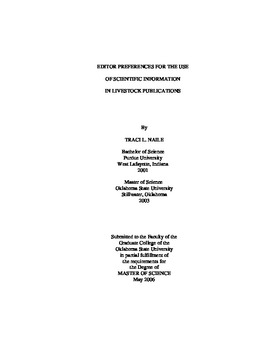| dc.contributor.advisor | Cartmell, Dwayne | |
| dc.contributor.author | Naile, Traci Lianne | |
| dc.date.accessioned | 2014-04-15T20:07:33Z | |
| dc.date.available | 2014-04-15T20:07:33Z | |
| dc.date.issued | 2006-05-01 | |
| dc.identifier.uri | https://hdl.handle.net/11244/8768 | |
| dc.description.abstract | The purpose of this study was to determine the use of scientific information in monthly livestock magazines through a survey of editor perceptions of the amount, type, and sources of information used. Editors of monthly livestock publications were surveyed using an online instrument. Reliability and validity of the instrument was determined by a panel of experts and pilot survey of weekly livestock publications. The source list for the 54-editor population was the 2005 Livestock Publications Council membership list. A census was used. Editors were initially contacted via telephone, then sent an introductory e-mail followed by a reminder e-mail. Survey responses were collected from January 27 through February 23. Data were analyzed and interpreted using descriptive statistics. After finding no differences in early and late respondents, the final survey response rate was 72 percent. Editors' identification of the most important topics agreed with audience perceptions of information needs and previous studies of information provided by agricultural journals, although lower rankings of policy and worker/employee safety information contradicted the importance of magazines identified by audiences in previous studies. The importance of certain gatekeeping criteria to editors reflected the general standards of accuracy and newsworthiness found in journalism, as well as editors' perceptions of their livestock audiences' information needs. The number and sources of information preferred coincided with source characteristics as criteria for using scientific information. The specific sources most preferred by editors also demonstrated the orientation of editors with other gatekeepers and the audience in selecting appropriate information for publication. Scientific information published during 2005 was similar to editors' rankings of topic importance and source preferences. The depth and overall use of scientific information during 2005 also supported the importance of delivering understandable scientific information to their agricultural audiences. The demographics of livestock publications editors and their magazines show similarities and differences to the earlier farm press, other gatekeepers and science communicators, and the mainstream media. | |
| dc.format | application/pdf | |
| dc.language | en_US | |
| dc.publisher | Oklahoma State University | |
| dc.rights | Copyright is held by the author who has granted the Oklahoma State University Library the non-exclusive right to share this material in its institutional repository. Contact Digital Library Services at lib-dls@okstate.edu or 405-744-9161 for the permission policy on the use, reproduction or distribution of this material. | |
| dc.title | Editor Preferences for the Use of Scientific Information in Livestock Publications | |
| dc.type | text | |
| dc.contributor.committeeMember | Sitton, Shelly | |
| dc.contributor.committeeMember | Blackwell, Cindy Southard | |
| osu.filename | Naile_okstate_0664M_1797.pdf | |
| osu.college | Agricultural Sciences and Natural Resources | |
| osu.accesstype | Open Access | |
| dc.description.department | Department of Agricultural Education, Communications, and Leadership | |
| dc.type.genre | Thesis | |
| dc.subject.keywords | agriculture | |
| dc.subject.keywords | communications | |
| dc.subject.keywords | science | |
| dc.subject.keywords | livestock | |
| dc.subject.keywords | gatekeeping | |
| dc.subject.keywords | editor | |
